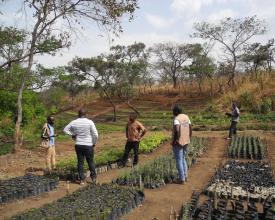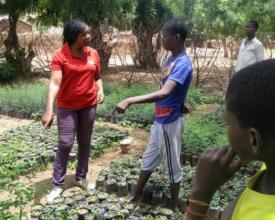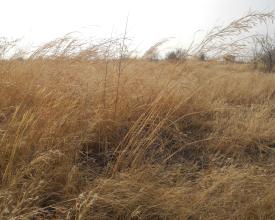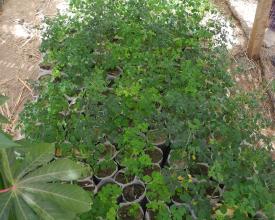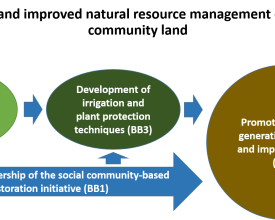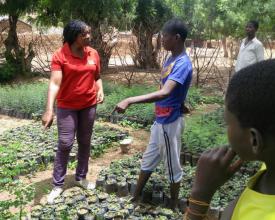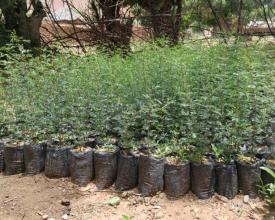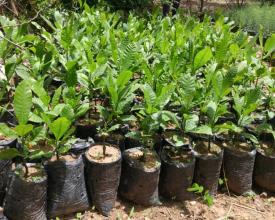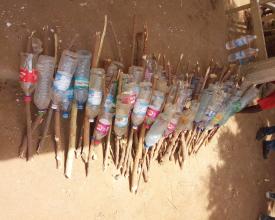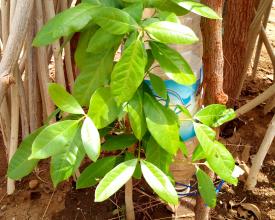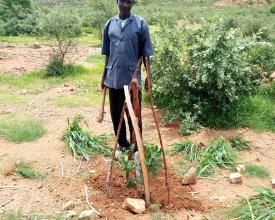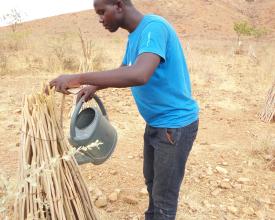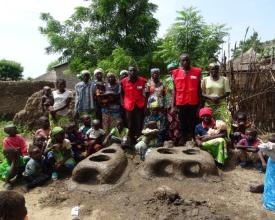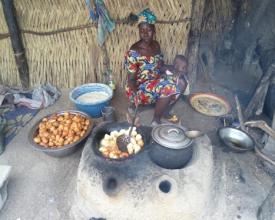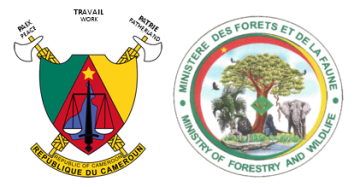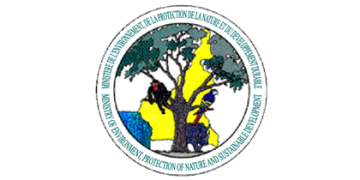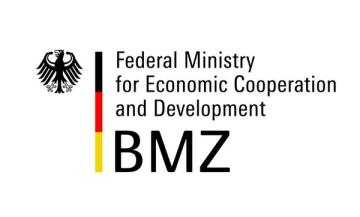
Restauración del paisaje forestal y mejora de la gestión de los recursos naturales de la comunidad de Mogazang
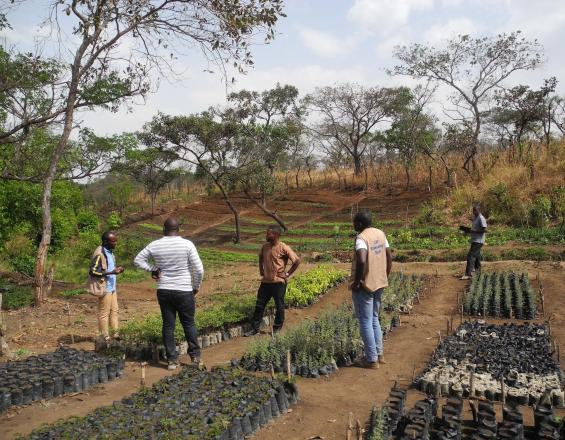
La desertificación y sus consecuencias amenazan el bienestar de la población del norte de Camerún, especialmente de los hogares rurales. La falta de leña para el fuego y la construcción, y la pobreza extrema son los principales problemas de la población de Mogazang. Los peligros climáticos, como el cambio de los regímenes de precipitaciones, agravan los riesgos para la población. La elaboración de un mapa por los miembros de la comunidad permitió delimitar una parcela de tierra degradada (10,74 ha) para su restauración. Adoptando un enfoque de "aprender haciendo", se probaron diferentes técnicas para restaurar la fertilidad del suelo. Mientras se esperaba a que la parcela fuera productiva, las mujeres recibieron formación en actividades alternativas generadoras de ingresos y en la construcción de cocinas mejoradas. La iniciativa contribuye así a los objetivos de AFR100 mediante la restauración de tierras degradadas, la reducción de la presión sobre los recursos naturales restantes y la generación de ingresos.
Contexto
Défis à relever
A pesar del acuerdo de todas las partes implicadas, ha resultado muy difícil mantener alejadas de la parcela de restauración a las ovejas y vacas callejeras. Por ello, se delimitó otra parcela dentro de la zona comunitaria para cultivar exclusivamente forraje para los animales. La parcela se protegió con tallos tejidos deIpomea carnea y deAzadirachta indica .
Las escasas precipitaciones de 2017 provocaron que un gran número de plantas se secaran. Esto desencadenó una nueva iniciativa para regar las plantas con riego por goteo, lo que llevó a la recuperación de más del 50% de las plantas marchitas.
Uno de los principales retos es movilizar a la comunidad para que se implique más en el seguimiento de las actividades del proyecto. Por eso hemos puesto en práctica un enfoque social comunitario en el que el compromiso de todos los miembros de la comunidad y el intercambio entre ellos fomentan el seguimiento de los esfuerzos de restauración.
Ubicación
Procesar
Resumen del proceso
Promover la apropiación de la iniciativa de restauración y la participación de todos los miembros de la comunidad de todas las clases sociales(BB1) fue la condición previa para iniciar las actividades de ejecución del proyecto. Esto garantizó el interés y la participación de los miembros de la comunidad en la microzonificación de la parcela seleccionada en función del tipo de suelo, la topografía y la identificación de especies arbóreas locales adaptadas(BB2). La microzonificación ha facilitado la aplicación de una reforestación útil, con una serie de técnicas específicas para proteger y regar los árboles. El vivero previsto, situado en el pueblo, con un pozo de agua permanente, desempeñará un papel fundamental para toda la iniciativa, especialmente el pozo de agua, ya que proporcionará agua para múltiples fines(BB3). A la espera de que la parcela sea productiva en términos de madera y otros servicios, las mujeres recibieron formación sobre la construcción de cocinas mejoradas, destinadas a reducir el consumo de leña. Además, se promovieron otras actividades generadoras de ingresos, como la recogida y transformación de productos forestales no madereros(PFNM)(BB4).
Bloques de construcción
Promover la apropiación de la iniciativa de restauración social comunitaria y la participación de todas las clases sociales
Se celebró una reunión inicial entre las autoridades tradicionales y religiosas de Mogazang para recabar toda la información útil y sensibilizar a la población. Como paso siguiente, se llevó a cabo un estudio socioeconómico para comprender las posibles repercusiones y retos sociales, económicos y medioambientales de la iniciativa de restauración. La elaboración de un mapa por parte de los miembros de la comunidad bajo la dirección del equipo asesor permitió delimitar una parcela de terreno degradado (10,74 ha) para su restauración. La iniciativa de reforestación tenía como objetivo proporcionar leña, forraje, productos alimenticios y plantas medicinales, entre otros. El gobierno es propietario de la parcela seleccionada, bajo la supervisión de la Oficina Ejecutiva de Desarrollo del pueblo. Sin embargo, está gestionada "por el pueblo, para el pueblo".
Factores facilitadores
- Asegurarse siempre de que se entienden bien las preocupaciones de la población y de que las soluciones propuestas contribuirán realmente a resolver su problema.
- Implicar a representantes de todos los grupos de la sociedad (especialmente mujeres y niños).
- Asegurarse de que no haya conflictos de intereses ni disputas sobre los derechos de propiedad de la tierra en relación con el emplazamiento del proyecto.
- Seleccionar a personas locales cualificadas con formación suficiente para redactar breves informes de actividad y prever su capacitación técnica y de gestión
Lección aprendida
- Dados los hábitos y costumbres de la comunidad musulmana de la zona donde se lleva a cabo la iniciativa, fue todo un reto implicar activamente a las mujeres en los debates.
- Posteriormente, pudimos demostrar las ventajas de incorporar la perspectiva de las mujeres en los debates y logramos así su mejor integración. De hecho, las mujeres son las que, a diario, recorren largas distancias en busca de leña, lo que justifica la necesidad de implicarlas en las actividades de la iniciativa.
- Para lograr el sentimiento de apropiación entre los beneficiarios es necesario contar con autoridades administrativas y tradicionales que los movilicen. Estas autoridades, sin embargo, tienden a hacer hincapié en el aspecto monetario, lo que puede reducir la consecución de los objetivos.
Microzonificación de la parcela seleccionada en función del tipo de suelo, la topografía y la identificación de especies vegetales y arbóreas locales adaptadas.
Los miembros de la comunidad y los expertos elaboraron un mapa topográfico de la parcela seleccionada en el que se mostraban los distintos tipos de suelo y las especies vegetales y arbóreas locales adaptadas. Se han identificado dos tipos principales de suelo:
- Los suelos de las laderas de las montañas: superficies pedregosas; el horizonte 1 (0 a 20 cm) es limo-arenoso con una mezcla de granos pedregosos; el horizonte 2 (20 a 40 cm) está dominado por piedras grandes y una pequeña proporción de tierra y el horizonte 3: (40 a más) no era accesible. Para este tipo de suelo, las especies apropiadas son: Acacia(Acacia nilotica, Acacia Sieberiana, Acacia seyal), Neem Azadirachta indica, Anogeissus leiocarpus, Jujube (Ziziphus mauritiana), Goma roja de río (Eucalyptus camaldulensis).
- El lecho del sitio está dominado por vertisoles (es decir, suelos con un alto contenido de minerales arcillosos expansivos) con ranuras de retirada locales: horizonte 1 (0 a 40 cm) compuesto de limo y arcilla y horizonte 2 (40 a más) una mezcla de limo, arcilla y granos pedregosos. Las especies adecuadas son: Khaya(Khaya senegalensis), Cassia (Cassia siamea), ciruelo negro africano (Vitex doniana), goma roja de río (Eucalyptus camadulensis), espino de invierno (Faidherbia albida), anacardo (Anacardium occidentale) y otros frutales.
En función de estos distintos tipos de suelo, una minizona permitió delimitar 11 bloques ocupados por ocho especies seleccionadas.
Factores facilitadores
- Plena implicación de los facilitadores locales designados, dispuestos a hacer un seguimiento diario de las actividades.
- Selección participativa de las especies de plantas y árboles para garantizar una reforestación útil
- Adopción del enfoque de microzonificación
Lección aprendida
Es fundamental tener en cuenta las características físicas de la parcela para el éxito de la iniciativa, incluidas las características del suelo y la topografía, implicando a expertos locales. Esto permite identificar soluciones para la restauración que sean sostenibles y rentables a corto, medio y largo plazo.
Desarrollo de técnicas específicas para proteger y regar las plantas
La comunidad ensayó varias técnicas para ahuyentar al ganado extraviado tras el periodo de plantación. Entre ellas, proteger la zona con un seto muerto de ramas espinosas, con varas tejidas deIpomea carnea ( gloria de la mañana rosa) sostenidas por postes y con alambre de hierro procedente de la carbonización de ruedas de coche desgastadas. Sin embargo, estos esfuerzos no tuvieron mucho éxito. Además, tras la larga estación seca y la escasez de lluvias en la región en 2017, la fuente de agua de la comunidad se secó y las plantas se marchitaron. La idea de recoger agua con latas vacías en el pozo de agua de la comunidad (~ 3 km) no era viable debido a la falta de recursos financieros.
Sin embargo, se recurrió a otro sistema mediante dispositivos de riego por goteo fabricados con botellas usadas recogidas en la ciudad. Los dispositivos de riego por goteo se fijaron al pie de las plántulas. El agua se extraía de barriles y se almacenaba in situ. Este sistema permitió regar las plántulas tres veces por semana, lo que permitió que casi el 40% de las plantas marchitas volvieran a crecer. También se ha finalizado la construcción de un vivero permanente con un pozo de agua.
Factores facilitadores
- La capacitación de los facilitadores locales en el método "aprender haciendo" para desarrollar técnicas de restauración permitió la producción de 2.600 plantas en 2017
-
Capacidad para desarrollar acciones puntuales que pueden mejorarse en función de la situación.
-
Enfoque de protección individual de las plantas. por ejemplo, uso de una esterilla para proteger las plantas (ver fotos)
- Uso de un sistema de riego por goteo con botellas de agua reutilizadas
- Fomento de la producción separada de forraje para el ganado
Lección aprendida
- Dificultad para acceder al agua, primordial para el crecimiento de los árboles frutales que requieren riego durante la larga estación seca. De los 4022 plantones plantados, 2162 están vivos y 1860 muertos en once bloques que contienen ocho especies frutales y forestales en agosto de 2017.
- Los beneficios de construir un vivero en la aldea con un pozo de agua in situ (producción permanente de plantas de calidad, abrevadero para el ganado, consumo humano y, por tanto, reducción de las enfermedades transmitidas por el agua, causantes de la elevada tasa de mortalidad infantil en la comunidad).
- La posibilidad de dividir la parcela en subparcelas de aproximadamente 500 m2, que se restaurarán gradualmente (año 1, año n+1, año n+2, ..., año n+5), con el fin de hacerla más segura
Promoción de actividades generadoras de ingresos y de cocinas mejoradas
La falta de leña y de madera para la construcción es un reto importante para los beneficiarios de la iniciativa. Por ello, ponemos en práctica un enfoque holístico e integrador:
- El refuerzo de las capacidades de los beneficiarios para crear y gestionar un espacio social comunitario, teniendo en cuenta los recursos necesarios.
- La recogida y transformación de PFNM de la parcela restaurada, como semillas de Neem para la producción de aceite (actividades generadoras de ingresos)
- Integración de la perspectiva de género: construcción de estufas mejoradas que llevan a cabo dos coordinadores de formación: Mujer/Hombre que supervisa las actividades, que a su vez formarán a Formadores de Relevo en los pueblos objetivo en construcción, sensibilización y medios de popularización de las estufas mejoradas y concienciación sobre el problema de la dendroenergía. Se utilizaron dos tipos de estufas mejoradas: "foyers améliorés 3 pierres", "foyers améliorés Bill-Bill". Aumentaron su fuente de ingresos y redujeron el uso de leña.
- Mientras los árboles y plantas recién plantados siguen creciendo, 35 mujeres han recibido formación para construir estufas mejoradas utilizando arcilla y paja, materias primas que se encuentran en la naturaleza (coste cero). Esto mejora las condiciones de vida de la población y reduce la presión sobre los recursos naturales restantes.
Factores facilitadores
- Participación efectiva de las mujeres
- Disponibilidad de la materia prima (arcilla y paja)
Lección aprendida
Dos mujeres de un pueblo vecino (Doualaré), formadas por expertos en dendroenergía de la GIZ, enseñaron a las mujeres del proyecto a construir y utilizar cocinas mejoradas. Este tipo de "formación de agricultor a agricultor" empodera a las mujeres y difunde las técnicas.
Impactos
Medioambiental:
- Plantación de cerca de 10.000 plantas, junto con la construcción de diques de retención de agua, en once bloques que comprenden ocho especies frutales (por ejemplo, mango, anacardo) y arbóreas (acacia).
- Protección del lugar contra el ganado extraviado y designación de una zona exclusiva para el cultivo de forraje.
- Utilización del agave sisal(Agave sisalana) para evitar la erosión hídrica, especialmente aguas abajo de la cuenca hidrográfica
- Mejora del microclima y estabilización de la erosión para contribuir a la mejora de la fertilidad del suelo mediante la plantación de especies vegetales y arbóreas
- regeneración natural asistida con tallos de Guiera(Guiera senegalensis), que han seguido creciendo gracias a la apertura de cortafuegos aguas arriba de la cuenca hidrográfica
Socioeconómicos:
- La población local aplica las capacidades adquiridas en la producción de compost
- Las mujeres construyeron cocinas mejoradas y las están utilizando
- Fortalecimiento de las capacidades técnicas y de gestión de diecinueve líderes del pueblo
- Se han plantado especies de alto valor (neem, anacardo, moringa) en la parcela de restauración para generar ingresos en el futuro.
- Participación de las mujeres en todas las fases de las distintas cadenas de valor, como la madera, los frutos comestibles y otros productos forestales no madereros (PFNM).
Beneficiarios
- Comunidad de Mogazang y aldeas circundantes (Gayak, Kossewa y Dogba)
- Autoridades tradicionales
- Autoridades territoriales descentralizadas
- Grupos de Interés Comunitario (GIC)
- Ministerio de Medio Ambiente y Protección de la Naturaleza
- Ministerio de Bosques y Fauna
Objetivos de Desarrollo Sostenible
Historia
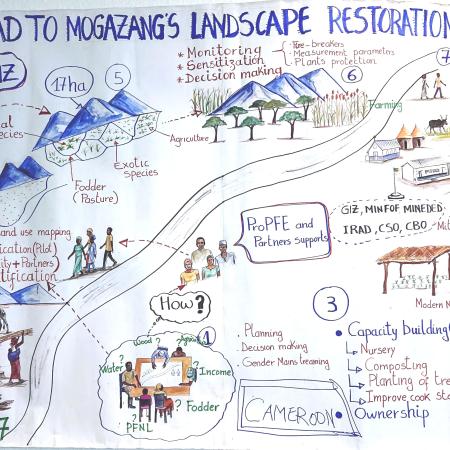
"La puesta en marcha de esta iniciativa de restauración permitió identificar las dificultades de los beneficiarios con el enfoque participativo e integrador basado en la comunidad social. Varias limitaciones sociales, ecológicas e institucionales obstaculizaron el progreso. Sin embargo, en todo momento se propusieron, debatieron y validaron posibles soluciones de forma consensuada. El uso combinado de los conocimientos locales tradicionales y la experiencia técnica garantiza que los resultados esperados estén a la altura de los recursos humanos, financieros y materiales invertidos. Un mínimo de cinco años consecutivos de seguimiento tras la plantación tiene como objetivo el desarrollo de un modelo de gestión territorial que pueda reproducirse en otras comunidades, teniendo en cuenta la gestión y el desarrollo de capacidades técnicas como principal factor facilitador de este tipo de iniciativas. Esta ampliación permite mejorar los medios de vida de la población rural, lo que forma parte de los compromisos nacionales e internacionales del gobierno camerunés." Makueti Josephine Therese, asesora técnica en silvicultura, Deutsche Gesellschaft für Internationale Zusammenarbeit (GIZ) Camerún.
